Department of Animal Nutrition

Head of the Department
Barbara Kowalik, PhD, DSc, institute professor
🖂 b.kowalik@ifzz.pl
Researches
Prof. PhD DSc. Marian Czauderna, 🖂 m.czauderna@ifzz.pl
PhD DSc. Grzegorz Bełżecki, institute professor, 🖂 g.belzecki@ifzz.pl
PhD DSc eng. Małgorzata Białek, institute professor, 🖂 m.bialek@ifzz.pl
PhD DSc eng. Paweł Konieczka, prof. UWM, 🖂 p.konieczka@ifzz.pl
PhD DSc Paweł Kowalczyk, 🖂 p.kowalczyk@ifzz.pl
PhD DSc Renata Miltko, institute professor, 🖂 r.miltko@ifzz.pl
PhD DSc Grzegorz Skiba,institute professor, 🖂 g.skiba@ifzz.pl
PhD DSc Ewa Święch, institute professor, 🖂 e.swiech@ifzz.pl
PhD DSc Anna Tuśnio, institute professor, 🖂 a.tusnio@ifzz.pl
PhD eng. Marcin Barszcz, 🖂 m.barszcz@ifzz.pl
PhD Małgorzata Majewska, 🖂 m.majewska@ifzz.pl
PhD eng. Monika Sobol, 🖂 m.sobol@ifzz.pl
MSc Kamil Gawin, 🖂 k.gawin@ifzz.pl
MSc Misza Kinsner, 🖂 m.kinsner@ifzz.pl
MSc Adrianna Konopka, 🖂 a.konopka@ifzz.pl
MSc Wiktoria Wojtak, 🖂 w.wojtak@ifzz.pl
Scientific and Engineering Staff
PhD DSc Agnieszka Białek 🖂 a.bialek@ifzz.pl
Engineering Staff
Eng. Natalia Frączek, 🖂 n.fraczek@ifzz.pl
MSc Aneta Kędzierska, 🖂 a.kedzierska@ifzz.pl
MSc eng. Urszula Wolska-Świętlicka, 🖂 u.wolska-swietlicka@ifzz.pl
Technical Staff
Malwina Krakowiak, 🖂 m.krakowiak@ifzz.pl
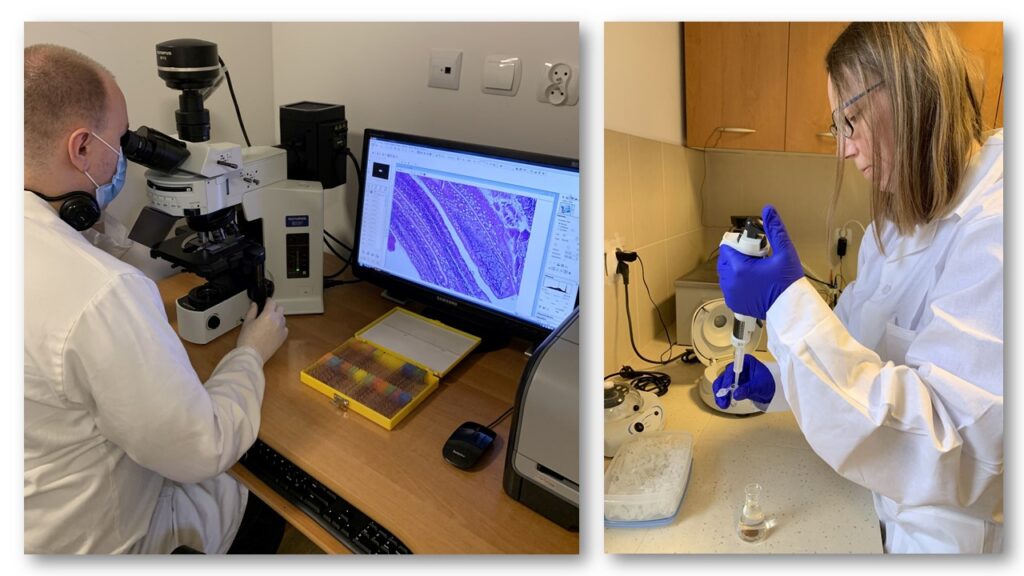
Current research topics
- Identification and characterisation of microorganisms present in fermentative chambers of digestive tract in mammals.
- Isolation and cultivation of microorganisms in vitro.
- Description of qualitative and quantitative changes of symbiotic rumen microflora and microfauna under bioactive feed constituents.
- Participation of rumen ciliates in methanogenesis and lipid metabolism.
- Isolation and characterisation of microbiological enzymes catalysing the digestion of carbs and structural carbohydrates (of plant and microbiological origin) in the rumen.
- Influence of feed ingredients on digestion processes in the rumen and in the small intestine, production and meat quality.
- Feed digestion in the rumen in sacco.
- Improving and developing methods of designating contents of selected feed constituents and measurements of protein synthesis in the microorganisms present in the rumen.
- Description of large intestine microflora in monogastric animals.
- Domestic protein sources in piglet and chicken feeding.
- Diet and oxidative stress in piglet and chicken.
- Influence of technological processes on nutritional value of legumes in the studies on chicken and piglets.
- Influence of bioactive substances on the immune system of gastrointestinal tract in monogastric animals.
- In vitro methods in the studies on nutritional components digestion and microflora activity.
- Studies on influence of fibre on gastrointestinal tract physiology.
- Influence of feeding factors on pig growth and welfare and quality of products.
- The quality of animal products depending on feeding and endogenous factors.
- Physiological role of CLA isomers in programming babies health via feeding mothers suffering from cancer (rat model).
- Influence of oil and antioxidants on fatty acid and amino acid profiles, anti-oxidative status and cholesterol in selected animal tissues.
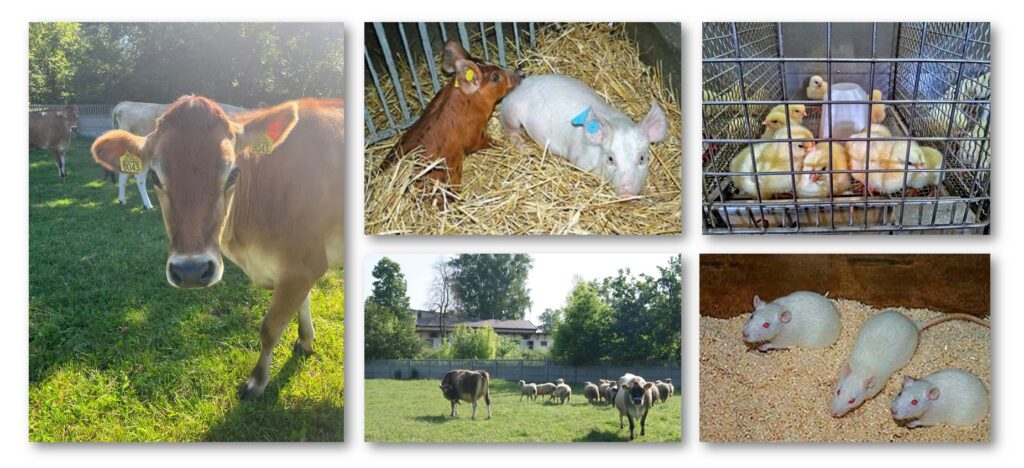
Main achievements
- Identification and characterisation of new bacteria species Treponema zioleckii and settlement of method describing bacteria biomass on the basis of mureine content (Piknova et al., 2008. FEMS Microbiol. Lett. 289, 166-172; Bełżecki et al., 2012. J. Anim Feed Sci. 21, 624-634).
- It was revealed that rumen ciliates can be used as potential hydrogen source in the fuel cell used to acquire electrical energy and that they are equipped with enzymes that can putrefact carbohydrates, including chitin (Piela et al., 2010. J. Microbiol. Biotechnol. 20, 1092-1100; Miltko et al., 2015. J. Anim. Feed Sci. 24, 203-207; Miltko et al., 2016. Arch. Anim. Nutr. 70, 425-440).
- It was noted that the addition of oak bark (Quercus) to sheep diets improved the number of rumen microorganisms and stimulated the exocrine activity of pancreas. Also, it was revealed that addition of lingonberry leaves (Vaccinium vitis idaea L.) to lamb diet improved the meat quality (Majewska et al., 2021. Anim. Biosci. 34, 1146-1156, Majewska et al., 2017. J. Anim. Feed Sci. 26, 354-358; Majewska and Kowalik, 2020. Eur. J. Lipid Sci. Tech. 122, 1900273).
- The addition of plant oils with the high amount of α-linolenic (linseed oil) and oleic (rapeseed oil) acids to sheep diets reduces the cellulose dispersion. Also, it was revealed that rapeseed oil negatively influences the pectinolic enzymes activity in the sheep rumen. What is more, it was observed that above mentioned oils increase the activity of pancreas lipase, and that linseed oil increases the quality of lamb meat more than rapeseed oil (Majewska et al., 2020. Livest. Sci. 240, 104175; Kowalik et al., 2018. J. Anim. Physiol. Anim. Nutr. 102, 1194-1198; Miltko et al., 2019. Asian-Austral. J. Anim. Sci. 32, 767-775).
- It was noted that carnosic acid and selenate added to the diet decrease the CH4 and CO2 emissions in the sheep rumen and improve the feed conversion efficiency in lambs. Also, it was observed that selenate decreases biohydrogenation of unsaturated amino acids in the sheep rumen (Białek et al., 2019. Livest. Sci. 226, 122-132; Miltko et al., 2016. Acta Vet.-Beograd 66, 373-391; Białek et al., 2020. Livest. Sci. 241, 104249).
- The addition of fish oil with organic selenium and carnosic acid to lamb diet increases the density and improves the biomechanical properties of lamb bones (Skiba et al., 2021. Animals 11, 230).
- Inulin-type fructans can contribute to piglets welfare improvement by increasing Bifidobacterium population, antioxidative activity and positive changes in protein expression in pig large intestine mucosa. So, positive influence on intestinal barrier functioning, protection from endotoxins and free radicals, and also possibility of inulin usage in diet prevention for large intestine diseases (Barszcz et al., 2016. Anim. Nutr. 70, 278-292; Barszcz et al., 2018. Anim. Prod. Sci. 58, 1109-1118; Herosimczyk et al., 2020. Animal 14, 1647-1658).
- It was revealed that zinc glycinate addition to piglet diet improves the Clostridium herbivorans population and the addition of potato fibre improves the activity of bacterial β-glycosidase in the large intestine, which results in the increased dietary fibre digestibility (Barszcz et al., 2019. Livest. Sci. 227, 37-43; Barszcz et al. 2021. Livest. Sci. 245, 104429).
- The high amounts of narrow-leaved lupin (Lupinus angustifolius) in the diet, and micronization process can negatively affect the content and activity of large intestine microflora in piglets. Also, it was noted that high amount of lupin in the diet can negatively affect the piglet weight gain (Tuśnio et al., 2020. Livest. Sci. 240, 104137).
- The interactions between protein and carbohydrates source in the diet influence the pig large intestine bacterial flora activity. The modification of proteolytic fermentation with the use of complex carbohydrates is possible, however the direction of such changes is dependent on the carbohydrates type. Raw potato starch intensifies the negative influence of the worse digested protein in the small intestine, and cellulose and pectin reduce the intensity of bacterial proteolysis (Taciak et al., 2017. Arch. Anim. Nutr. 7, 192-209).
- The supplementation of inulin to the diet reduces the negative influence of high-fat diet rich in saturated fatty acids on bone health in growing pigs and health-promoting and technological properties of pork meat, and also dependence of n-6/n-3 PUFA in the diet and body and growing piglets bone properties were estimated (Sobol et al., 2018. Br. J. Nutr. 119: 1111-1118; Przybylski et al., 2019. J. Anim. Physiol. Anim. Nutr. 103, 593-602; Sobol et al., 2019. Br. J. Nutr. 121, 508–518).
- It was observed that low proportion of dietary n-6/n-3 PUFA and increased vitamin E level in chicken diet negatively influence DNA damage in intestinal epithelial cells, and gut morphology. Also increasing level of vitamin E in breeding diets results resistance to the activity of acetylsalicylic acid in broiler chickens with induced inflammation. Made for the first time on poultry the analysis of oxygen consumption by blood platelets mitochondria revealed that acetylsalicylic acid does not negatively influence the mitochondria functioning, and quite the contrary, can counteract negative results of inflammation (Konieczka et al., 2018. Poult. Sci. J. 97, 149-158; Konieczka et al., 2019. Vet. Res. 50, ID 65).
- It was revealed that nano selenium (Nano-Se) and the Cannabis sativa extract in broiler chicken nutrition can assist the functioning of intestinal barrier in birds prone to bacteria perfringens infection responsible for necrotizing enterocolitis in poultry (Konieczka et al., 2020. Vet. Res. 51,
ID 141). - CLA isomers in the diets of rats with induced mammary gland cancer suppress peroxidation of polyunsaturated fatty acids and reduce the level of aterogenic saturated fatty acids and cholesterol oxidation (Białek et al., 2019, Nutrients 11, 2032; Białek et al., 2020, Animals 10, 464).
- Pomegranate seed oil was found to influence the fatty acids profile and content, to decrease the activity of desaturases and to hold down creating the products of lipid oxidation in livers of rats (Białek et al., 2017. Prostagland. Other Lipid Mediat. 131, 9-16).
- Coumarin derivatives, 1.2 alfa-aminoamdes, diaryloetanols and δ-lactons, toxically affect bacterial cells of coliK12, R1-R4 in the gastrointestinal tract. Such compounds induce oxidative stress in pathogenic bacteria cells and suppress their replication. It was also revealed that these derivatives act more effectively and selectively to certain E. coli strains, at the same time are more biologically stable and more toxic for humans than traditionally used antibiotics (Kowalczyk et al., 2020. Materials 13, 2499; Kowalczyk et al., 2020. Materials 13, 5169; Kowalczyk et al., 2021. Materials 14, 1025; Kowalczyk et al., 2021. Materials 14, 2956).
Selected publications
- Czauderna M., Wojtak W., Białek M., Białek A. 2024. Optimization of high-efficient pre-column sample treatments and C18-UFLC method for selective quantification of selected chemical forms of tocopherol and tocotrienol in diverse foods. Food Chemistry 437, 137909; https://doi.org/10.1016/j.foodchem.2023.137909; 200 pkt.; IF = 8,8; Q1
- Barszcz M., Gawin K., Tuśnio A., Konopka A., Święch E., Taciak M., Skomiał J., Tokarčiková K., Čobanová K., Grešáková L. 2023. Comparison between organic and inorganic zinc forms and their combinations with various dietary fibers in respect of the effects on electrolyte concentrations and mucosa in the large intestine of pigs. International Journal of Molecular Sciences 24, 16743; https://doi.org/10.3390/ijms242316743; 140 pkt., IF 5,6; Q1
Czauderna M., Karpińska M., Woliński J., Zaworski K., Białek M., Pierzynowski S., Wojtak W., Pierzynowska K. 2023. Improved lipid saponification method for chromatographic quantification of fatty acids in pig erythrocytes – an important lipidomic biomarker of effectiveness of dietary fat supplementation for pigs used as large animal model for human studies. Journal of Animal and Feed Sciences 32 (4), 385-399; https://doi.org/10.22358/jafs/163632/2023; 100 pkt.; IF = 1,0; Q3
Konieczka P., Ferenc K., Jørgensen J.N., Hansen L.H.B., Zabielski R., Olszewski J., Gajewski Z., Mazur-Kuśnirek M., Szkopek D., Szyryńska N., Lipiński K. 2023. Feeding Bacillus-based probiotics to gestating and lactating sows is an efficient method for improving immunity, gut functional status and biofilm formation by probiotic bacteria in piglets at weaning. Animal Nutrition 13, 361-372; https://doi.org/10.1016/j.aninu.2023.03.003; 100 pkt.; IF=6,30; Q=1
Koszelewski D., Kowalczyk, P., Brodzka A., Hrunyk A., Kramkowski K., Ostaszewski R. 2023. Enzymatic synthesis of a novel coumarin aminophosphonates: Antibacterial effects and oxidative stress modulation on selected E. coli strains. International Journal of Molecular Sciences 24, 7609; https://doi.org/10.3390/ijms24087609; 140 pkt; IF 5,60; Q1
Kowalczyk P., Koszelewski D., Brodzka A., Kramkowski K., Ostaszewski R. 2023. Evaluation of antibacterial activity against nosocomial pathogens of an enzymatically derived α-aminophosphonates possessing coumarin Scaffold. International Journal of Molecular Sciences 24, 14886; https://doi.org/10.3390/ijms241914886; 140 pkt; IF 5,60; Q1
Maculewicz E., Pabin A., Dziuda Ł., Białek M., Białek A. 2023. Selected exogenous (occupational and environmental) risk factors of cardiovascular diseases in military and aviation. Journal of Clinical Medicine 12 (23), 7492; https://doi.org/10.3390/jcm12237492; 140 pkt.; IF 3,9; Q2
Majewska M.P., Miltko R., Bełżecki G., Kędzierska A., Kowalik B. 2023. Rumen protozoa population and carbohydrate-digesting enzymes in sheep fed a diet supplemented with hydrolysable tannins. Annals of Animal Science 23 (2) 561-570; https://doi.org/10.2478/aoas-2022-0095; 200 pkt.; IF 1.9; Q2
Konieczka P., Szkopek D., Kinsner M., Kowalczyk P., Michalczuk M., Bień D., Banach J., Matusevičius P., Bogucka J. 2022. Cannabidiol and nano-selenium Increase microvascularization and reduce degenerative changes in superficial breast muscle in C. perfringens-infected chickens. International Journal of Molecular Science 24, 237; https://doi.org/10.3390/ijms24010237; 140 pkt.; IF 5,60; Q1
Konieczka P., Wojtasik-Kalinowska I., Poltorak A., Kinsner M., Szkopek D., Fotschki B., Juśkiewicz J., Banach J., Michalczuk M. 2022. Cannabidiol affects breast meat volatile compounds in chickens subjected to different infection models. Scientific Reports 12, 18940; https://doi.org/10.1038/s41598-022-23591-1; 140 pkt.; IF 4,60; Q1
Konieczka P., Żelechowska E., Przybylski W., Jaworska D., Sałek P., Kinsner M., Jankowski J. 2022. The sarcoplasmic protein profile of breast muscle in Turkeys in response to different dietary ratios of limiting amino acids and Clostridium perfringens-induced inflammation. Poultry Science 101, 102195; https://doi.org/10.1016/j.psj.2022.102195; 140 pkt.; IF 4,40; Q1
Lepionka T., Białek M., Czauderna M., Szlis M., Białek A., 2022., Lipidomic profile and enzymes activity in hepatic microsomes of rats in physiological and pathological conditions. International Journal of Molecular Sciences. 23, 422; https://10.3390/ijms23010442; 140 pkt; IF=6,208; Q1
Sobol M., Skiba G., Raj S., Kowalczyk P., Kramkowski K., Świątkiewicz M., Grela E.R. 2022. Chemical body composition and bone growth of young pigs as affected by deficient, adequate and excess dietary phosphorus supply. Annals of Animal Science 22 (4),
1363–1372; https://doi.org/10.2478/aoas-2022-0061; 200 pkt.; IF 1.9; Q2Święch E., Tuśnio A., Taciak M., Barszcz M. 2022. Modulation of mucin secretion in the gut of young pigs by dietary threonine and non-essential amino acid levels. Animals 12, 270; https://doi.org/10.3390/ani12030270; 100 pkt.; IF 3,0; Q1
Lepczyński A., Herosimczyk A., Barszcz M., Ożgo M., Michałek K., Grabowska M., Tuśnio A., Szczerbińska D., Skomiał J. 2021. Diet supplemented either with dried chicory root or chicory inulin significantly influence kidney and liver mineral content and antioxidative capacity in growing pigs. Animal 15, 100129; https://doi.org/10.1016/j.animal.2020.100129; 200 pkt.; IF 3,7; Q1
Majewska M.P., Miltko R., Bełżecki G., Kowalik B. 2021. Population of protozoa and carbohydrate-digesting enzymes in the rumen of sheep fed a diet supplemented with yeast Saccharomyces cerevisiae. Small Ruminant Research 205, 106544; https://doi.org/10.1016/j.smallrumres.2021.106544; 100 pkt;
IF 1.8; Q2Skiba G., Raj S., Sobol M., Kowalczyk P., Grela E.R. 2021. Role of polyphenols in the metabolism of the skeletal system in humans and animals – A Review. Annals of Animal Science 21 (4), 1275–1300; https://doi.org/10.2478/aoas-2021-0040; 200 pkt; IF 1.9; Q2
Tuśnio A., Barszcz M., Święch E., Skomiał J., Taciak M. 2020. Large intestine morphology and microflora activity in piglets fed diets with two levels of raw or micronized blue sweet lupin seeds. Livesock Science 240, 104137; https://doi.org/10.1016/j.livsci.2020.104137; 140 pkt.; IF 1,8; Q1
Laboratory of Analysis of Gastrointestinal Tract Protective Barrier


Head of the Laboratory
PhD eng. Marcin Barszcz
🖂 m.barszcz@ifzz.pl
Laboratory of Analysis of Gastrointestinal Tract Protective Barrier is a new organisational unit of Department of Animal Nutrition established in 2018 through the funding of Ministry of Science and Higher Education within a framework of an application for a financial support of Institute’s restructuring in 2018-2019.
Research topics:
- The Laboratory performs studies on the gut immune system of livestock and laboratory animals.
- The aim of research is to determine the effect of nutrition (diet, nutrients, bioactive compounds) on the innate and active immunity of the gut and microbiota role in barrier function shaping.
- The Laboratory analyses biological material (tissues, body fluids etc.) on order and is open for a cooperation with local and foreign scientific units and other subjects.
Offer:
- The Laboratory has at its disposal a wide range of analytical methods enabling determining the parameters specific for gastrointestinal tract protective barrier and immune system functioning.
- The equipment also enables performing analyses not related to the Laboratory’s specificity.
- For preparation of biological material for studies and in most analyses performed in the Laboratory other equipment of Department of Animal Nutrition is used.
Sample type:
- Animal tissues, homogenates, supernatants
- Cell suspensions
- Body fluids
- Depending on the analysis the laboratory accepts fresh or frozen samples
Analyses
Flow cytometer BD FACSCelesta:
- subpopulation of immune cells (isolated from the gastrointestinal tract and blood)
- granulocyte and monocte functions:
− phagocytosis
− oxidative burst
− others
Spectrofluorimeter SpectraMax iD3:
- mucin concentration:
- concentration of secretory immunoglobulin A, other antibodies and proteins (ELISA)
- activity of antioxidant enzymes
- other microplate analyses based on absorbance, fluorescence and luminescence measurements
Cell counter Arthur:
- cell count in suspension (standardisation for flow cytometry and other analyses)
- cell viability (propidium iodide method)
- cell cycle (propidium iodide method)
- apoptosis (annexin V and propidium iodide method)
- green fluorescence protein (GFP) expression
- red fluorescence protein (RFP) expression
MIC qPCR thermocycler
- expression of genes coding, e.g. mucin, cytokines, transporting proteins, microRNA
Histological analysis
- tissue processing and embedding in paraffin blocks
- cutting of biological materials embedded in paraffin blocks (rotary microtome HM355S)
- histological staining:
− haematoxylin-eosin (HE)
− phloxin-tartrazine (PT)
− alcian blue-periodic acid-Schiff reagent (AB-PAS)
− toluidine blue (TB)
- microscopic examination
− intraepithelial lymphocyte count in the small and large intestine of pigs (HE)
− mast cell count (TB)
− goblet cell type and count (AB-PAS)
− Paneth cell count in the small intestine of laboratory rodents (PT).
The Laboratory’s offer will be extended soon by other analytical methods, which are being developed currently.
Equipment
Flow cytometer BD FACSCelesta
Digital flow cytometer BD FACSCelesta (Becton Dickinson, Franklin Lakes, New Jersey, USA) enables simultaneous measurement of 12 fluorescences per cell, equipped with 3 lasers (blue, red, violet), sampler for sample acquisition from 96-well microplate and FACS Flow Supply System for sheath dosing from 20 l container and waste disposal. It is used in immunology researches (e.g. cell populations, phagocytosis test, oxidative burst test), cell biology (e.g. apoptosis, cell cycle), and others.
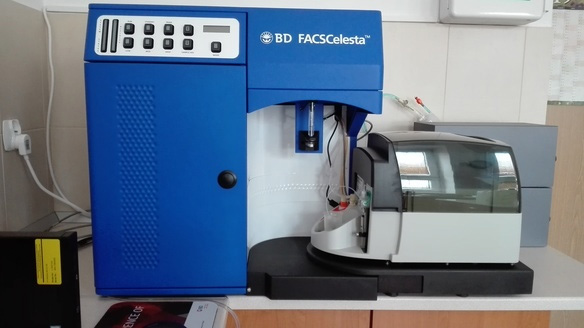
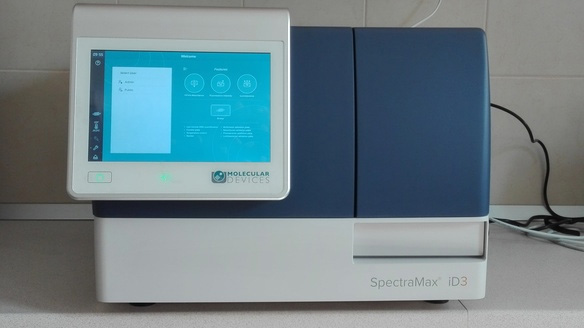
Spectrofluorimeter SpectraMax iD3
Multi-mode microplate reader SpectraMax iD3 (Molecular Devices, San Jose, California, USA) enables measurements of absorbance, fluorescence (from top and bottom), luminescence and kinetic measurements. It is equipped with thermostated reading chamber enabling temperature regulation (from 5 °C above ambient to 66 °C) and plate shaking. It is used for biochemical analyses, immune-enzymatic tests (ELISA), and others.
Automatic cell counter Arthur
Automatic, fluorescence cell counter Arthur (NanoEnTek, Seoul, South Korea) is a 3-channel counter (bright field, green fluorescence, red fluorescence) enabling fast analyses of cell suspension, expression of green and red fluorescence proteins, cell viability, apoptosis and cell cycle in 25 µl sample volume. The counter is compatible with a wide variety of eukaryotic cells.
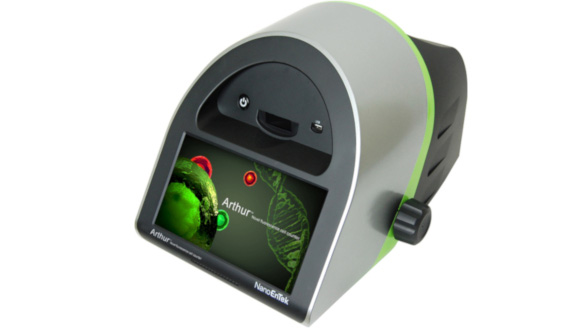
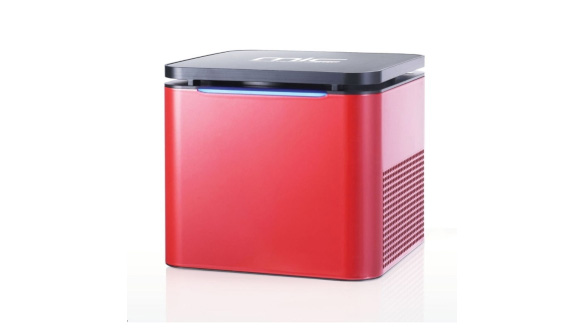
MIC qPCR thermocycler
MIC thermocycler (Bio Molecular Systems, Upper Coomera, Australia) for gene expression analysis by real-time PCR, based on magnetic induction technology, 4-channel model with a rotor for 48 samples ensures constant optical pathway, temperature homogeneity and precision. It enables PCR performing in reaction volume from 10 to 35 µl.
CO2 Incubator MIDI 40
CO2 incubator MIDI 40 (Thermo Scientific, Waltham, Massachusetts, USA) for cell culture, ensures suitable CO2 concentration, air humidity and temperature, with air coat and 40 l, stainless steel working chamber. It is dedicated for short-term lymphocyte cultures (proliferation tests).
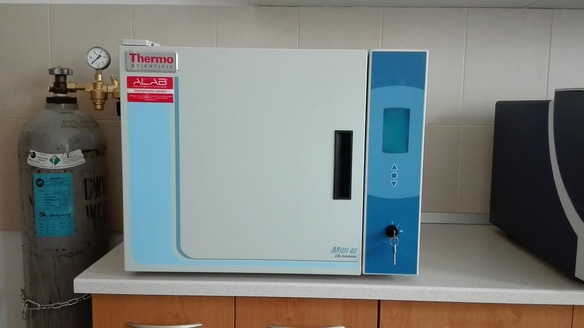

Automatic rotary microtome HM355S
Automatic rotary microtome HM355S (Thermo Shandon Limited, Runcorn, UK) with a section transfer system (STS) on a wet tray and Cool-Cut system for precise cutting of biological material embedded in paraffin blocks. Microtome enables cutting of histological slices of 0.5 to 100 µm thickness. Cool-Cut system keeps for a long time a low temperature of paraffin block in a holder and along with STS ensures maximal elasticity of slices.
Dry air sterilizer/oven FN500
Dry air sterilizer/oven FN500 (Nüve, Ankara, Turkey) of 120 l working capacity, microprocessor controlled, with forced air ventilation ensuring high temperature homogeneity and stability. Temperature range: from +5 °C above ambient to 250 °C. It is used for dry heat sterilization of tools, drying of histological slices and sample incubation during analyses.
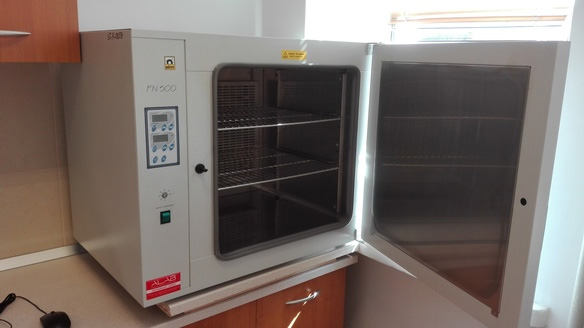
Contact: The Kielanowski Institute of Animal Physiology and Nutrition Polish Academy of Sciences,
Instytucka 3, 05-110 Jabłonna
PhD eng. Marcin Barszcz
🖂 m.barszcz@ifzz.pl; tel. 22 765 33 00; 22 765 33 30


